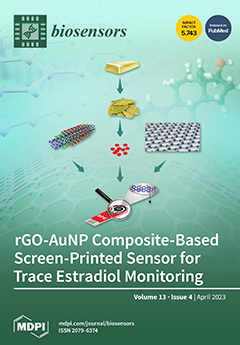Herein, we report results of the studies relating to the development of an impedimetric, magnetic bead-assisted supersandwich DNA hybridization assay for ultrasensitive detection of
Neisseria gonorrhoeae, the causative agent of a sexually transmitted infection (STI), gonorrhea. First, a conductive ink was formulated
[...] Read more.
Herein, we report results of the studies relating to the development of an impedimetric, magnetic bead-assisted supersandwich DNA hybridization assay for ultrasensitive detection of
Neisseria gonorrhoeae, the causative agent of a sexually transmitted infection (STI), gonorrhea. First, a conductive ink was formulated by homogenously dispersing carboxylated multiwalled carbon nanotubes (cMWCNTs) in a stable emulsion of terpineol and an aqueous suspension of carboxymethyl cellulose (CMC). The ink, labeled
C5, was coated onto paper substrates to fabricate
C5@paper conductive electrodes. Thereafter, a magnetic bead (MB)-assisted supersandwich DNA hybridization assay was optimized against the
porA pseudogene of
N. gonorrhoeae. For this purpose, a pair of specific 5′ aminated capture probes (SCP) and supersandwich detector probes (SDP) was designed, which allowed the enrichment of target gonorrheal DNA sequence from a milieu of substances. The SD probe was designed such that instead of 1:1 binding, it allowed the binding of more than one T strand, leading to a ‘ladder-like’ DNA supersandwich structure. The MB-assisted supersandwich assay was integrated into the
C5@paper electrodes for electrochemical analysis. The
C5@paper electrodes were found to be highly conductive by a four-probe conductivity method (maximum conductivity of 10.1 S·cm
−1). Further, the biosensing assay displayed a wide linear range of 100 aM-100 nM (10
9 orders of magnitude) with an excellent sensitivity of 22.6 kΩ·(log[concentration])
−1. The clinical applicability of the biosensing assay was assessed by detecting genomic DNA extracted from
N. gonorrhoeae in the presence of DNA from different non-gonorrheal bacterial species. In conclusion, this study demonstrates a highly sensitive, cost-effective, and label-free paper-based device for STI diagnostics. The ink formulation prepared for the study was found to be highly thixotropic, which indicates that the paper electrodes can be screen-printed in a reproducible and scalable manner.
Full article






